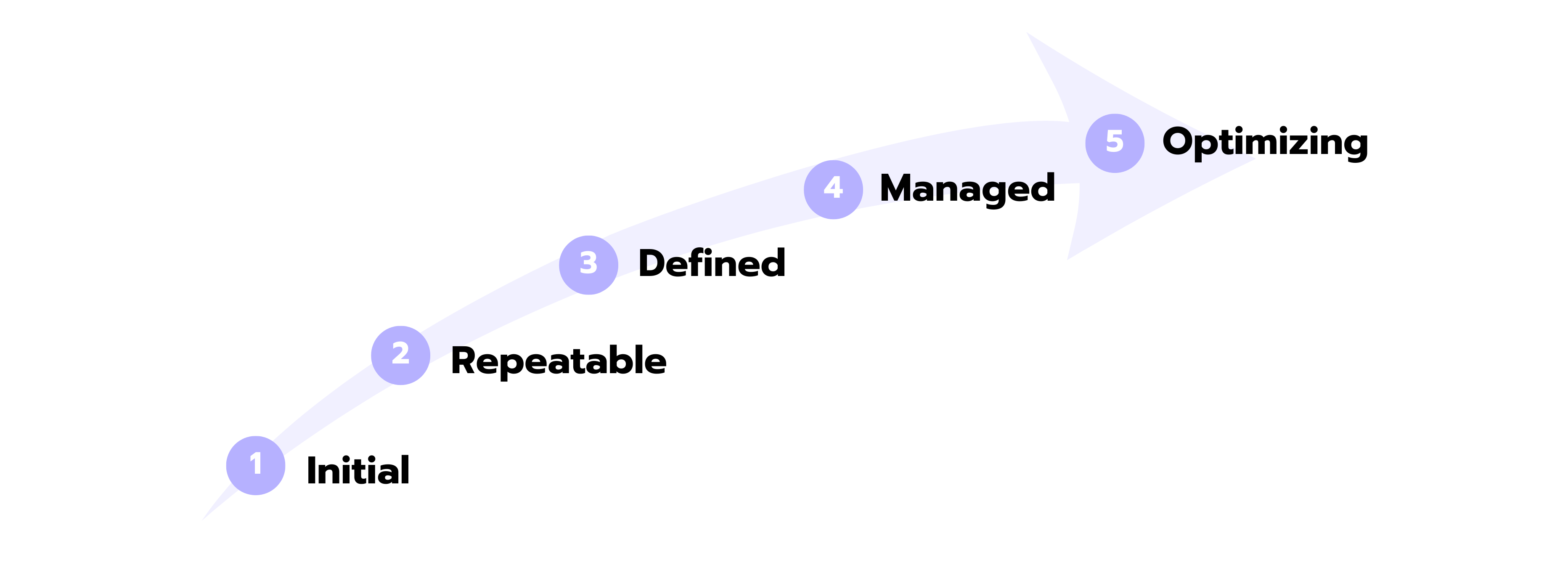A career in consulting requires a deep understanding of various methods and models that can help clients optimize their processes and maximize performance. One such model is the Capability Maturity Model (CMM), which can serve as a compass for organizations seeking to improve their project management and service capabilities.
Developed by the Software Engineering Institute (SEI) at Carnegie Mellon University, the CMM, as well as its extension to the Capability Maturity Model Integration (CMMI), focuses on improving processes within an organization. The models provide a better view of process improvement within five levels (initial to optimized). Each level represents a different level of process maturity and guides an organization toward continuous process improvement.
Understanding the Levels of CMM

- Initial:
Processes are ad hoc and disorganized. The organization lacks stable procedures, and success often depends on individual effort and courage. - Repeatable:
Basic project management techniques are established, and successes can be repeated because the necessary process discipline is in place to repeat previous triumphs on projects with similar applications. - Defined:
The organization's standardized processes are documented and understood. All projects use an approved, customized version of the organization's standard process for developing and maintaining software. - Managed:
Detailed measurements of the software process and product quality are collected. Both the software process and products are quantitatively understood and controlled. - Optimizing:
Continuous process improvement is enabled through quantitative feedback from the process and the testing of innovative ideas and technologies.
These levels represent a maturity progression in terms of process capability and organizational effectiveness. Organizations can assess their current level and strive to advance to higher levels to improve their software development practices and achieve better outcomes.
CMM in Action: An Example
Consider a software development company that often misses deadlines, delivers poor-quality products, and exceeds budgets (Level 1: Initial). The company can use CMM to improve its performance. By implementing project management tools and establishing basic process management (Level 2: Repeatable), the company can begin to deliver projects on time and on budget. As the company continues to refine, define, and document its standard practices (Level 3: Defined), it can ensure greater consistency and predictability in its project deliverables.
Further down the road, the company could begin to collect and analyze metrics on process and product quality (Level 4: Managed) to gain a deeper understanding of its operations and identify potential areas for improvement. Finally, using this quantitative feedback, the company would continuously refine and improve its processes (Level 5: Optimizing), remaining agile and adaptable in the face of changing requirements and market conditions (see Stacey Matrix).
Similar Models to CMM
- Capability Maturity Model Integration (CMMI):
The Capability Maturity Model Integration (CMMI) is an evolution of the original Capability Maturity Model (CMM). It was developed by the Software Engineering Institute (SEI) to provide an even more comprehensive method for assessing and improving an organization's processes and capabilities. Which we will discuss in more detail below. - People Capability Maturity Model (People CMM):
Also developed at Carnegie Mellon, this model focuses on improving talent management processes within an organization. Like the CMM, the People CMM has five maturity levels, from 'Initial' to 'Optimizing.' The focus is on attracting, developing, and retaining talented individuals and teams. - COBIT (Control Objectives for Information and Related Technologies):
This framework helps organizations control and manage their information technology. It aligns with CMM's structured improvement approach, but is broader in scope. COBIT has six principles and seven core competencies and focuses on areas such as stakeholder needs, end-to-end governance, and continuous improvement. - ISO 9001:
ISO 9001 is a standard that sets the criteria for a quality management system. It helps companies and organizations be more efficient and improve customer satisfaction. Although not the same as CMM, it shares a similar focus on continuous process improvement.
Applying CMM in a Case Interview
For example, a case where the Capability Maturity Model could be applied is as follows: an ambitious tech start-up is struggling to deliver its projects on time and within budget. Look for a comprehensive strategy to improve project management capabilities. How would you help the company?
Using the CMM, you can structure and present your answer as follows:
- Assess the current state:
Start by saying that there is a need to understand the existing processes and determine where they are on the CMM scale. For example, the processes may be chaotic and inconsistent, indicating that they are at Level 1: Initial. - Outline Strategy:
Next, outline the plan to help the organization get to Level 2: Repeatable. This could include, for example, establishing basic project management techniques and creating robust processes capable of delivering successful projects on an ongoing basis. - Show results:
Paint a picture of how implementing this strategy would transform the client's operations. How would they be able to replicate their successes based on the established processes? How would this result in improved project delivery times and staying within budget? Outlook:
Finally, look to the future and point to the next steps for continuous process improvement, from refining and defining standard practices (Level 3: Defined) to collecting detailed metrics and using them to further improve processes (Levels 4 and 5: Managed and Optimizing).

